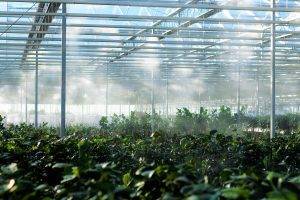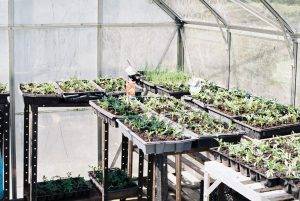8 Tips To Keep Your Greenhouse Cool During The Summer Heat

Greenhouses are a fantastic addition to any home, offering a haven for plants to flourish and thrive. However, maintaining an optimal environment within a greenhouse, especially during the scorching summer heat, poses its own set of challenges. Ensuring your greenhouse remains cool is crucial for the well-being of your plants. In this article, we’ll delve into the reasons behind the need for cooling and provide eight valuable tips on how to keep your greenhouse cool during the summer.
How Hot Can Greenhouses Get?
Greenhouses, when exposed to direct sunlight, can become surprisingly hot. The temperature inside can rise significantly higher than the outside temperature. In some cases, the greenhouse temperature can exceed 90°F (32°C), creating an environment that is less than ideal for plant growth. The ideal temperature for greenhouses is about 80°F (26.7°C) – 85°F (29.4°C). Understanding the potential heat build-up is the first step in implementing effective cooling strategies.
Why You Need to Keep It Cool?
Maintaining an optimal temperature within your greenhouse is not just a matter of comfort; it’s a fundamental aspect of ensuring the health and vitality of your plants. The significance of keeping your greenhouse cool during the summer cannot be overstated, and here’s why:

Preventing Plant Stress
Plants, like any living organism, have their comfort zones. When exposed to excessive heat, they undergo stress, disrupting essential physiological processes. Stress can manifest in various ways, from slowed growth to diminished yield and compromised overall health. By maintaining a cool environment, you provide your plants with the conditions they need to thrive.
Avoiding Wilting and Dehydration
High temperatures accelerate the rate of water loss through a process called transpiration. When plants can’t replenish water lost through their leaves quickly enough, they wilt. Wilting not only compromises the aesthetic appeal of your greenhouse but also indicates that your plants are under significant water stress. Cooling measures help regulate transpiration, preventing wilting and dehydration.
Protecting Against Plant Death
Extreme heat poses a direct threat to the survival of your plants. Prolonged exposure to high temperatures can lead to irreversible damage, eventually causing plant death. This not only results in the loss of your cultivated greenery but also undermines the efforts and investment you’ve put into your gardening endeavors. Cooling your greenhouse is, therefore, a preventive measure against potential plant fatalities.
Mitigating the Risk of Pests and Diseases
Elevated temperatures create an inviting environment for pests and diseases to thrive. Stressed and weakened plants become more susceptible to attacks, and the warmth of a greenhouse can amplify the proliferation of harmful organisms. By keeping your greenhouse cool, you create a less favorable habitat for pests and diseases, reducing the risk of infestations and infections.
Preserving Optimal Growing Conditions
Every plant has its preferred range of temperature for optimal growth. Maintaining a cool environment ensures that your greenhouse remains within this desired range, promoting healthy development and maximizing the potential of your cultivated plants. This is particularly crucial for those aiming to achieve bountiful harvests and vibrant, flourishing greenery.
Enhancing Photosynthesis Efficiency
Photosynthesis, the process by which plants convert light into energy, is sensitive to temperature fluctuations. Extreme heat can disrupt this vital process, hindering the plant’s ability to produce food and nourish itself. A cool greenhouse provides the ideal conditions for efficient photosynthesis, contributing to the overall well-being and productivity of your plants.
What Happens if the Greenhouse Gets Too Hot?
Allowing your greenhouse to become excessively hot can have detrimental effects on both the structure itself and the well-being of your plants. Understanding the potential consequences of high temperatures is crucial for implementing effective cooling strategies. Here’s what may happen if your greenhouse gets too hot:
1. Structural Damage
High temperatures can subject the greenhouse structure to stress, especially if it’s made of materials like plastic or glass. Prolonged exposure to intense heat may lead to warping, degradation, or even structural failure. This not only compromises the integrity of your greenhouse but also necessitates costly repairs or replacements.
2. Reduced Plant Growth and Yield
Elevated temperatures can stunt the growth of your plants and significantly reduce their yield. The stress induced by excessive heat hampers essential physiological processes, limiting the plant’s ability to photosynthesize and produce the energy needed for robust growth. This can result in smaller harvests and diminished overall plant quality.
3. Increased Water Requirements
Hot conditions intensify the transpiration rate of plants, leading to increased water loss. As a result, your plants will require more frequent and substantial watering to compensate for the higher evaporative demand. Failure to meet these increased water needs may result in dehydration, further compromising plant health.
4. Risk of Scorching and Sunburn
Intense sunlight, combined with high temperatures, poses a risk of scorching and sunburn to your plants. Leaves may develop brown, crispy edges or exhibit discoloration due to excessive exposure to sunlight. This not only affects the visual appeal of your plants but also indicates cellular damage that can impede their overall vitality.
5. Vulnerability to Pests and Diseases
Overheated conditions create a favorable environment for the proliferation of pests and diseases. Stressed plants are more susceptible to infestations, and the warmth of a hot greenhouse accelerates the reproduction and activity of harmful organisms. This increased vulnerability can lead to widespread damage and the need for intensive pest and disease management.
6. Negative Impact on Pollination
High temperatures can negatively impact the pollination process, crucial for the development of fruits and seeds. Excessive heat may interfere with the activity of pollinators, such as bees, leading to poor fruit sets. This can result in suboptimal yields and affect the reproductive success of flowering plants in your greenhouse.
7. Risk of Plant Fatality
Prolonged exposure to extreme heat can push plants beyond their tolerance limits, leading to irreversible damage and, ultimately, plant death. This not only results in the loss of your cultivated greenery but also undermines the time and effort invested in nurturing your plants.
8 Tips to Keeping Greenhouses Cool During the Summer:
1. Shade Cloth – Your Cooling Ally
Installing shade cloth is a simple yet effective way to shield your greenhouse from the intense summer sun. It helps regulate the amount of sunlight entering the greenhouse, preventing overheating. Consider quality options from providers like ShadyPlains for optimal results.
2. Strategic Plant Placement
Position your plants strategically, placing taller varieties on the sun-exposed side to provide natural shading for shorter, more sun-sensitive plants. This not only creates a harmonious growing environment but also contributes to temperature control.
3. Ventilation – A Breath of Fresh Air
Implementing a robust ventilation system is paramount. Natural ventilation through well-placed vents, windows, and doors promotes air circulation, preventing excessive heat buildup. Mechanical options like exhaust fans and evaporative coolers enhance this process.
4. Cooling with Water – The Refreshing Splash:
Daily spraying of the greenhouse floor helps maintain a cooler atmosphere. As the water evaporates, it absorbs heat, contributing to a more comfortable temperature for your plants.
5. Strategic Door Propping and Circulating Fans
Propping doors strategically and using circulating fans are simple yet effective ways to move hot air out and facilitate cooler air circulation within the greenhouse.
6. Embrace Nature’s Shade – Plant a Tree
Planting a sturdy tree that sheds leaves in winter provides natural shade cover. This not only protects your greenhouse from excessive sunlight but also allows for increased light exposure in the winter months.
7. Whitewash Paint – Old Technique, Modern Benefits
Applying whitewash paint to greenhouse surfaces reflects sunlight, preventing excessive exposure to intense rays. This age-old technique remains effective in moderating temperatures and safeguarding your plants.
8. Ceiling Fans – Harnessing Airflow
Install a ceiling fan directly below the roof vents, reversing the spin to pull hot air up and out. This efficient method aids in maintaining a comfortable and consistent temperature within the greenhouse.
It’s Important to Properly Take Care of Your Greenhouse:
In conclusion, the key to a thriving greenhouse lies in its proper care, especially when combating the challenges posed by summer heat. By implementing these eight tips – from utilizing shade cloth to embracing natural shade – you can create an environment that fosters healthy plant growth while mitigating the risks associated with high temperatures. Remember, a well-maintained greenhouse not only enhances your gardening experience but also ensures the longevity and prosperity of your cherished plants.

